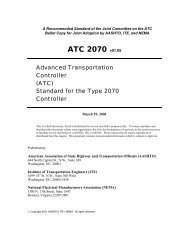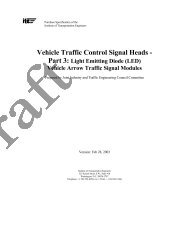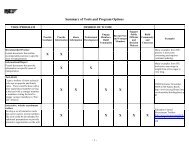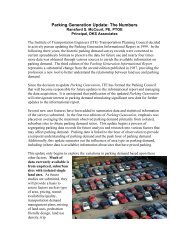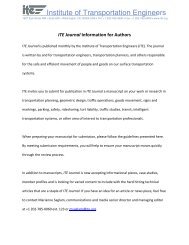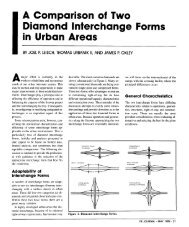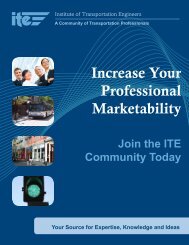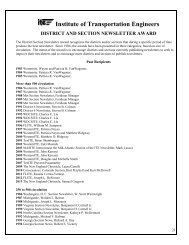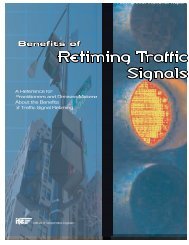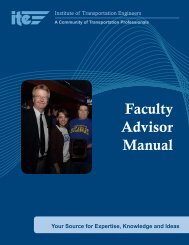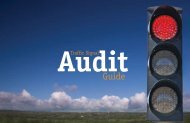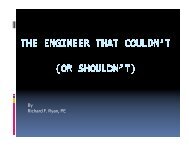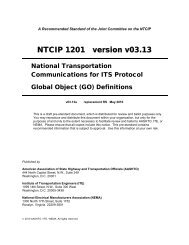Comparison of Office/Business-Related Trip Generation Rates
Comparison of Office/Business-Related Trip Generation Rates
Comparison of Office/Business-Related Trip Generation Rates
Create successful ePaper yourself
Turn your PDF publications into a flip-book with our unique Google optimized e-Paper software.
<strong>Comparison</strong> <strong>of</strong> <strong>Office</strong>/<strong>Business</strong>-<strong>Related</strong><br />
<strong>Trip</strong> <strong>Generation</strong> <strong>Rates</strong><br />
Howard S. Steini<br />
and Cary D. Vick2<br />
The 1987 ITE Triu <strong>Generation</strong> Report (4th Edition) contains several<br />
improvements to the earlier report including a larger data base, more land<br />
uses, and plotting <strong>of</strong> actual data. Most important is the derivation <strong>of</strong> trip<br />
generation (regression) equations that allow the calculation <strong>of</strong> trips based<br />
on the actual development size (e.g. square feet, acres, or employees).<br />
This feature is critical because trip rates (e.g. trips per 1,000 square feet)<br />
can vary significantly, by the size <strong>of</strong> the development, particularly for large<br />
retail or <strong>of</strong>fice-related uses. The basic rationale for this is that the larger<br />
the use, the less an additional square foot <strong>of</strong> building area adds to the trip<br />
generation rate. Larger developments have may have multiple uses<br />
allowing for multi-purpose trips.<br />
<strong>Office</strong> <strong>Related</strong> Land Uses<br />
The 1987 ITE <strong>Trip</strong> <strong>Generation</strong> Report includes the following <strong>of</strong>ficerelated<br />
land use categories:<br />
Light Industrial (110): TypicaI industries included in this category were<br />
printing plants, material testing, and assemblers <strong>of</strong> data processing<br />
equipment. The emphasis <strong>of</strong> this land use ~tegow is not manufacturing.<br />
It should be noted that all the sites studied by ITE were free-standing<br />
facilities devoted to one use. The average gross floor space per employee<br />
was 440 square feet or 2.3 employees per l,OtM square feet.<br />
At one extreme might be a fast-food restaurant whose mere presence will<br />
generate a number <strong>of</strong> trips, but it size would not be a good indicator <strong>of</strong><br />
the actual number <strong>of</strong> trips it would generate. Most people go to a fast<br />
foodrestaurant basedon hs location (andwhetherornoth hasa drivein<br />
window) not whether it has 4,500 square feet rather than 4,0CClsquare<br />
feet. To some extent the importance <strong>of</strong> location and access are also<br />
better indicators <strong>of</strong> trips to smaller retail shopping centers, particularly<br />
during rush hours. Larger centers, where a shopper wiB have a larger<br />
selection <strong>of</strong> merchants, will attract more traffic. However, above some<br />
size the addition <strong>of</strong> a small amount <strong>of</strong> retail space will general have a<br />
negligible effect on the peak hour trips.<br />
With <strong>of</strong>fice uses the phenomena is not quite the same. With smaIl<br />
buildings the tenants may be somewhat unrelated and each <strong>of</strong>fice will<br />
require basic support staff (e.g. receptionist) regardless <strong>of</strong> the number <strong>of</strong><br />
employees. As the building size increases, the support ratio <strong>of</strong> support<br />
staff to other workers wiB decrease and more space might be devoted to<br />
equipment. At some size, the building may attract a single tenant and/or<br />
be located in a <strong>of</strong>fice park or CBD area where transit use and ridesharing<br />
would be a factor.<br />
This paper will deal with the trip generation rates <strong>of</strong> <strong>of</strong>fice-related uses.<br />
In addition to the issue <strong>of</strong> the change in trip rates as the size <strong>of</strong> the<br />
development increases, there are also several types <strong>of</strong> land use categories<br />
that have components that may be general <strong>of</strong>fice buildings, industrial,<br />
commercial, production and warehouse components. Many business<br />
developments are now being designed to accommodate these different<br />
types <strong>of</strong> uses within the same development or even building structure.<br />
Additionally, many business developments are being designed in a campus<br />
type setup so that the buildings are related and may contain support retail<br />
(e.g. deli, <strong>of</strong>fice supplystore). Consequently, a largenumbertrips maybe<br />
internal tothesiteandthenumber<strong>of</strong>trips tothedevelopment thatcome<br />
fromexternal sources wouldbe significantly lessthanthe sum <strong>of</strong> the<br />
individual buildings. Some external trips may only enter the site once, but<br />
visit many <strong>of</strong> the buildings (e.g. postman, deliveries, salesmen, etc.).<br />
The objective <strong>of</strong> this paper is to demonstrate how trip generation rates for<br />
<strong>of</strong>ficelmsiness-related land use change as the size <strong>of</strong> development<br />
increases. <strong>Comparison</strong>s will be made for the magnitude <strong>of</strong> trips and trip<br />
rates among the different land use categories.<br />
1. AsSociate<br />
Callow Associates, Inc.<br />
Reston, Virginia<br />
2. Vice President<br />
Callow Associates, Inc.<br />
Reston, Virginia<br />
Industrial Park (130): These contain a number <strong>of</strong> industrial <strong>of</strong> related<br />
facilities and are characterized by a mix <strong>of</strong> manufacturing, service, and<br />
warehousing with a wide variation in the proportion <strong>of</strong> each use. Some<br />
industrial parks may contain one or two dominant tenants while other<br />
contain many different tenants. The average gross floor space per<br />
employee was 529 square feet or 1.89 employees per 1,000 square feet.<br />
The ITE Report lists a transit trip factor <strong>of</strong> 0.038 weekday transit trip<br />
ends per 1,000 square feet <strong>of</strong> gross ffoor area,<br />
General Oflice Building (710): This category contains all different types<br />
<strong>of</strong> <strong>of</strong>fice building(s). These may have one or more tenants and include<br />
pr<strong>of</strong>essional services, insurance companies, company headquarters, and may<br />
include services for tenants such as banks, restaurants or cafeterias, and<br />
service retail facilities. This category contains the most data points. The<br />
average number <strong>of</strong> employees per 1,000 square feet was 4.17, but ranged<br />
from 2.16 to 8.00 and generally decreased with increasing building size.<br />
No overall transit trip rates are given.<br />
Ofllce Park (750): These are generally subdivisions <strong>of</strong> planned unit<br />
developments containing <strong>of</strong>fice buildings and support services such as<br />
banks, restaurants, and service stations arranged in a park or campus-like<br />
setup. No employee density data is given. The ITE Report lists a transit<br />
trip factor <strong>of</strong> 0.13 weekday transit trip ends per 1,000 square feet <strong>of</strong> gross<br />
floor area.<br />
Research Center (760): These are groups <strong>of</strong> buildings devoted to research<br />
and development activities and include <strong>of</strong>fices and light fabrication areas.<br />
The average gross floor area per employee was 450 square feet or 2.2<br />
employees per 1,000 square feet <strong>of</strong> floor area. The ITE Report lists a<br />
transit trip factor <strong>of</strong> 0.43 weekday transit trip ends per 1,000 square feet<br />
<strong>of</strong> gross floor area.<br />
<strong>Business</strong> Park (770): These consist <strong>of</strong> a group <strong>of</strong> flex-type buildings<br />
served by a common roadway system similar to an <strong>of</strong>fice or industrial<br />
park. The buildings generally are single level, but occasionally are two<br />
stories. Typically 20 to 30 percent <strong>of</strong> the space in the buildings are<br />
<strong>of</strong>fices, but the majority is warehousing or light industrial uses. The<br />
buildings are designed to be flexible to house different types <strong>of</strong> tenants<br />
which vary from start-up companies to established small companies. The<br />
backside <strong>of</strong> many buildings is served with a garage door.<br />
The ITE Report contains limited guidance about using these land use<br />
categories. The 1987 Report notes that the General <strong>Office</strong> building<br />
category (710) overlaps with other <strong>of</strong>fice-related categories [i.e. <strong>Office</strong><br />
Park (750)], but more data is needed to better define the differences<br />
among <strong>of</strong>fice-related land use categories. It is suggested that the<br />
General <strong>Office</strong> BuildIdg category Deused when estimating trip generation<br />
for one or more <strong>of</strong>fice buildings in a single development. Furthermore.<br />
402 ITE 1989 Compendium <strong>of</strong> Technical Papers
ifthebuildings are isolated it is suggested that the buildings be estimated<br />
individually. When the buildings are interrelated the ITE Report suggests<br />
that the total area <strong>of</strong> all buildings be used to calculate trip generation.<br />
If other uses such as banks or restaurants are included in the<br />
development, then the trip generation should be treated as a mixed-use<br />
development. Finally the ITE Report states that the <strong>Office</strong> Park category<br />
should be used when the breakdown <strong>of</strong> the individual buildings is not<br />
known.<br />
<strong>Comparison</strong><strong>of</strong>ITE Report<strong>Trip</strong><strong>Generation</strong>Data<br />
Tables 1, 2, and 3 present peak hour trip generation data and equations<br />
by several trip generation variables for <strong>of</strong>fice-reIated land use categories<br />
from the 1987 ITE <strong>Trip</strong> <strong>Generation</strong> Report. (It should be noted that<br />
some summary data was not presented in the 1987 Report and was take<br />
from the 3rd Edition, 1983.) Table 1 presents this data based on the<br />
building gross floor area which is probabIy the most common form <strong>of</strong> the<br />
data used. Most <strong>of</strong>ten the parcel size and FAR (ratio <strong>of</strong> gross floor area<br />
<strong>of</strong> buildings to square footage <strong>of</strong> the site) are known and the building<br />
sizes can be estimated. Table 2 presents the data on an employee basis.<br />
This data is more accurate than the other categories in predicting trip<br />
generation, but in planning new development the actual number <strong>of</strong><br />
employees and employee densities are not known. Table 3 compares these<br />
data by number <strong>of</strong> acres in the site. Afthough the number <strong>of</strong> acres in a<br />
site are known, these data are not directly comparable because building<br />
FARs and employee densities significantly differ among <strong>of</strong>fice-related land<br />
uses and these factors would significant affect trips to the site.<br />
Consequently, this paper will explore in detail only the relationship <strong>of</strong><br />
these rates on a building gross floor area basis because these rates are the<br />
most used and comparable basis for calculating trip generation.<br />
Irrcspcctivc <strong>of</strong> the bask for calculation, it is reassuring thatthe<br />
directional split<strong>of</strong>tripsto<strong>of</strong>fke-related sitesduringAM and PM peak<br />
hours is generally the same, although theOffimParksappeartohavea<br />
s]ighlly higher percentage <strong>of</strong> their trips in the peak direction than the<br />
other categories. It is also interesting to note that, in general, the average<br />
trip generation rates in the AM peak are roughly equal to the PM peak<br />
(with the PM peak sometimes slightly higher) regardless <strong>of</strong> the trip<br />
generation variable. However, it is disturbing that the actual number <strong>of</strong><br />
studies in any <strong>of</strong> the categories is small and the range <strong>of</strong> trip generation<br />
ra(es observed was quite large within each land use category, <strong>of</strong>ten an<br />
order <strong>of</strong> magnitude (10 times) apart.<br />
,% might be expected the peak hour trip generation rates per employee<br />
arc very similar among the different land use categories when computed<br />
on an employee basis because it is primarily employees accounting for<br />
trips to the site during the peak hours. Vehicle occupancy does no differ<br />
significantly among these land use categories. Comparing the other trip<br />
generation variables indicates that, in general, the General <strong>Office</strong> Building<br />
(710) category had the highest average trip generation rates. There<br />
seems to be a pattern among these data in that categories Light Industry<br />
(110) and Industrial Park (130) have significantly lower rates (about half)<br />
than the other categories. Next highest would be the Research Center<br />
(760) followed by the <strong>Business</strong> Park and <strong>Office</strong> Park categories.<br />
Finally, Table4 presents theaveragedailytraffic tripgeneration estimates<br />
andregression equations forthevarious<strong>of</strong>ficerelated landusecategories<br />
basedon thesameset<strong>of</strong>tripgeneration variables. The datainthistable<br />
indicate different trendsthanthepeakhourdata.Specifically, therek<br />
Icssdifference betweenthe industrial usesand the ResearchCenter<br />
catcgoty.More importantly, thereisalsolessdifference betweenthe<br />
General<strong>Office</strong>category andthe<strong>Business</strong>and<strong>Office</strong>Parkcategories. In<br />
fact, the <strong>Business</strong> Park category has the highest daily trip rate per l,OtXt<br />
square feet <strong>of</strong> gross building space.<br />
It is satisfying that the general trends noted above follow what would be<br />
expected by examining the definitions <strong>of</strong> these <strong>of</strong>fice-related land use<br />
categories. The industrial categories are generally less intense in<br />
development and their employee per square foot densities and have fewer<br />
trips during the peak hours and throughout the day. The other campusstyle<br />
larger devckrpments such as <strong>Office</strong> Park and <strong>Business</strong> Park have less<br />
peak hour traffic than the GeneraI <strong>Office</strong> Building category, but have<br />
comparable or even higher daily traffic perhaps due to their other uses in<br />
the development such as banks and restaurants. The Research Center<br />
category had peak hour trip rates similar to the Parks due to ifs Iower<br />
employee density, but they typically do not include the other uses and<br />
consequently had an average daiiy trip rate similar to the industrial<br />
categories.<br />
<strong>Comparison</strong> <strong>of</strong> <strong>Trip</strong> <strong>Generation</strong> Equations<br />
The previous Tables also presented the trip generation equations that<br />
were derived from the data to predict trips based on the three variables<br />
(i.e. building floor a:ea, site acres and employees). The best-tit regression<br />
equations were dertved from the employee data with most equations<br />
having an R-squared value greater than 0.9. However, as explained above,<br />
our analysis will deal with the equations for trips per 1,000 square feet<br />
gross building area. it is important to note that almost alI <strong>of</strong> the best-fit<br />
regression equations derived to estimate peak hour or ADT trips are loglinear<br />
equations reflecting the following format:<br />
<strong>Trip</strong>s = A x (variable)B, where B is less than 1<br />
(typically 0.75- 0.90).<br />
This relationship illustrated the scenario detailed in the introduction that<br />
for an addition unit <strong>of</strong> development a decreasing number <strong>of</strong> additional<br />
trips are generated.<br />
Tables5 and6 presenthetripgeneration estimates foreach<strong>of</strong>theland<br />
usecategories basedon thebuilding areaequations50,030and500,0Ml<br />
squaref@ respectively. lnaddition! theeffective tripgeneration ratesfor<br />
theGeneral<strong>Office</strong>Building (710)category werecomputedbydividing the<br />
number<strong>of</strong>tripsderivedfromthetripgeneration equationbythebuilding<br />
area(i.e., 50,000or500,000). Fortheotherlandusecategories, theirtrip<br />
ratesweredividedagainby theGeneral<strong>Office</strong>Buildingratestodevelop<br />
theirequivalence index.Forexample,a 50,000ResearchCenterbuilding<br />
would generate 52 percent <strong>of</strong> the trips compared to an equivalent size<br />
General <strong>Office</strong> building. These equivalency indices directly compare the<br />
lrip generation <strong>of</strong> these other <strong>of</strong>fice-related land use categories with that<br />
<strong>of</strong> the General <strong>Office</strong> category. From comparing these two tables it is<br />
evident that the trip generation rates dramatically decrease as building size<br />
increases, particularly the average daily trips. Specifically, compared to a<br />
50,000 square foot General <strong>Office</strong> building, a 500,003 square foot<br />
building(s) will have trip generation rates 28 percent less for AM peak<br />
hour trips, 32 percent less for PM peak hour trips and 44 less percent for<br />
daily trips.<br />
Comparing the <strong>of</strong>fice equivalent indices indicate many <strong>of</strong> the trends noted<br />
earlier about the average trip rates; the industrial uses generate about half<br />
the traffic <strong>of</strong> the General <strong>Office</strong> category. However, the results<br />
concerning the campus style <strong>of</strong>fice developments are different. Based on<br />
these equations, as the size <strong>of</strong> the development increases, the <strong>Office</strong> Park<br />
category will generate more AM peak hour trips than the General <strong>Office</strong><br />
category as well as more daily trips. The <strong>Business</strong> Park category will<br />
generate more peak direction traffic than the General <strong>Office</strong> category at<br />
the larger development sizes.<br />
To better illustrate these relationships Figures 1, 2, and 3 show the AM<br />
peak, PM peak and ADT trip generation rates derived for many different<br />
building sizes as a function <strong>of</strong> square feet and the <strong>of</strong>fice equivalency<br />
indices for tbe other land use categories. From these figures, the decline<br />
<strong>of</strong> trip generation rates as the development size increases is quite clear.<br />
The changes in the other <strong>of</strong>fice-related trip rates relative to the General<br />
<strong>Office</strong> category are also displayed. It should be noted that a decreasing<br />
trend in <strong>of</strong>fice equivalency indices means that the trip rate for the other<br />
<strong>of</strong>fice-related land use category decreases more than the General <strong>Office</strong><br />
(710) category. Conversely, an increasing trend in the <strong>of</strong>fice equivalency<br />
index means that the other land use category does not decrease as much<br />
as the General <strong>Office</strong> category indicating that the trip rate for this land<br />
use is less affected by increasing size <strong>of</strong> development.<br />
Ingeneral, thetrends<strong>of</strong>the<strong>of</strong>ficeequivalency indices fortheindustrial<br />
landusecategories (i.e., 110and 130)aremixed, but generally decrease<br />
ITE 1989 Compendium <strong>of</strong> Technical Papers 403
as the size <strong>of</strong> the development increases. This indicates that the trip rates<br />
for these land use categories decrease more as the size <strong>of</strong> development<br />
increased compared to the General <strong>Office</strong> category. In contrast, the <strong>of</strong>fice<br />
equivalency indices for the Research Center category increased as<br />
development size increases. The <strong>of</strong>fice equivalency rates for <strong>Office</strong> Park<br />
category remain constant for AM peak hour trips, but decrease for PM<br />
peak trips and increase for ADT. The <strong>of</strong>fice equivalency indices for the<br />
<strong>Business</strong> Park category increased by about 50 percent for AM peak trips,<br />
but decreased slightly for PM peak hour trips and increased slightly for<br />
the ADT. Overall, the most significant changes occurred for ADT, where<br />
all the <strong>of</strong>fice equivalency indices for almost all the other <strong>of</strong>fice-related<br />
land use categories increased. That is, the decline in ADT volumes that<br />
occurs for the General <strong>Office</strong> category is more dramatic than other land<br />
use categories, particularly the campus-style <strong>of</strong>fice developments.<br />
To some extent all this analysis may confuse the issue, but in the context<br />
<strong>of</strong> what each category represent, the results follow our earlier<br />
observations. Regardless <strong>of</strong> <strong>of</strong>fice-related land use category, larger<br />
developments have significantly lower trip generation rates than smaller<br />
developments. Furthermore, at small development sizes, although the<br />
rates between the General <strong>Office</strong> (710) category and the other <strong>of</strong>ficerelated<br />
land use categories differ substantially, the magnitude <strong>of</strong> the<br />
difference in the number <strong>of</strong> trips may not be large enough to have any<br />
practical significance. In fact, some <strong>of</strong> the cumpus-style categories really<br />
don’t apply to small developments. At the larger development sizes, the<br />
industrial land uses have a trip generation rate that is roughly 55 to 70<br />
percent <strong>of</strong> the General Building <strong>Office</strong> category. This is also true <strong>of</strong> the<br />
Research Center category. The results for the campus-style developments<br />
are mixed, but both land use categories resulted in higher ADT volumes<br />
than the General <strong>Office</strong> category. The <strong>Office</strong> Park category had a higher<br />
(aPproxirnately15 percent) inboundAM peaktripratethantheGeneral<br />
<strong>Office</strong>category, but theoutboundPM peaktripratewas lower(also<br />
about15percent).The <strong>of</strong>f-peak direction tripratesforthe<strong>Office</strong>Park<br />
category arelessthattheGeneral<strong>Office</strong>category, 5 percentlowerinthe<br />
AM peakhourand 32 percentlowerbtthePM peakhour. For the<br />
<strong>Business</strong>Parkcategorythepeakdirection ratesare10 to17 percentless<br />
thantheGeneral<strong>Office</strong>category, butthe<strong>of</strong>f-peak rateswerehigherthan<br />
theGeneralOffkecategory.<br />
Conclusions and Recommendations<br />
<strong>Trip</strong>generationisone <strong>of</strong> thebasicassumptionsto determinetraffic<br />
impactandthemostappropriate datashouldbe used. The ITE 1987 <strong>Trip</strong><br />
<strong>Generation</strong> Report presents trip generation data and regression equations<br />
to apply to the planned development scenario. (Although, the 1987 ITE<br />
<strong>Trip</strong> <strong>Generation</strong> Report provides convenient data, the possibility <strong>of</strong> taking<br />
traffic counts at similar development sites to the one planned should not<br />
be ignored.) Several categories are defined that describe <strong>of</strong>fice-related<br />
land uses as detailed in this article. The choice <strong>of</strong> the most appropriate<br />
land use category should be made by comparing the proposed development<br />
scenario with those defined in the ITE Report. As demonstrated in<br />
article, each <strong>of</strong> these categories has different trip generation rates and<br />
characteristics.<br />
In general, our analysis has demonstrated that as the size <strong>of</strong> the<br />
development increases, the trip generation rate per square foot <strong>of</strong><br />
development decreases. The decision to model an <strong>of</strong>fice-related<br />
development as one unified group <strong>of</strong> buildings that has shared trips among<br />
its buildings is the most critical choice. Calculating trip generation for a<br />
development by adding each individual building will result in significantly<br />
higher (perhaps double) traffic volumes than treating them as one<br />
development. Furthermore, when analyzing large developments, the<br />
selection <strong>of</strong> the appropriate land use category and its trip rates are also<br />
a critical factor in traffic forecasting process. This study found that the<br />
trip generation rates for the various <strong>of</strong>fice-related land use categories were<br />
consistent with their definitions and should be applied accordingly.<br />
Finally, although the Research Center (760) category is grouped in the<br />
700 series with General <strong>Office</strong> (710), <strong>Office</strong> Park (750) and <strong>Business</strong> Park<br />
(770), its trip generation characteristics are more similar to the General<br />
Industrial (110) and Industrial Park (130) categories.<br />
TABLE 1: 1987 TRIP GENERATION DATA AND EQUATIONS FOR OFFICE RELATED LANO USE CATEGORIES PER 1000 GROSS SQUARE FOOTAGE<br />
lTE CCOE #<br />
AM PEAK<br />
PM PEAK<br />
t# STIXI1ES<br />
An(PH)]<br />
LANO<br />
USE<br />
AVERAGE<br />
RATES<br />
RANGEOF F1TTEO CURVE OIRECTICUAL<br />
RATES EWATION OtSTRISUTIC+l<br />
AVERAGE<br />
RATES<br />
RANGk OF F1TTEO CURVE DIRECT ICUAL<br />
RATES EWATt ON OISTRISUTION<br />
——<br />
——<br />
— —<br />
110<br />
[23(20)1<br />
GENERAL LIGHT<br />
lNOUSTRIAL<br />
o.%<br />
0.17-4.0 Ln(T)=0.70Ln(sf )+l.54 8S% inter<br />
12% exit<br />
1.0.4<br />
0.14-4.5 Ln(T)=0.71 Ln(sf)+l .47 12% enter<br />
88x exit<br />
130<br />
[21(21)1<br />
I NOUSTRlAL PARK 0.93<br />
0.31-2.28 Ln(T).O. S4Ln(sf)+0.89 82X enter<br />
18% exit<br />
0.97<br />
0.30-2.85 T= l/((1.04/sf )+ O.00026) 21% enter<br />
79% exit<br />
71O*<br />
[25(24)1<br />
GENERALOFFICE 2.23<br />
RUILOING<br />
1.2-5.9 Ln(T)=O.86Ln(sf)+l .34 87% enter<br />
13% exit<br />
2.2<br />
0.8-6.4 Ln(T)=0.83Ln(sf )+l.46 16% inter<br />
84!4●xit<br />
750<br />
[25 (27)1<br />
OFFtCE 1.88<br />
PARK<br />
1.25-5.89 Ln(T)=0.86Ln(sf )+l.46 89?4 enter<br />
11% exit<br />
1.47<br />
0.17-4.5 Ln(T).O. ~Ln(sf)+l .91 13%enter<br />
87S exit<br />
760<br />
t17(18)l<br />
RESEARCH 1.24<br />
CENTER<br />
0.37-2.90 Ln(T)=0.98Ln(sf )+0.21 91% enter<br />
9S ●xit<br />
0.94<br />
0.40-4.13 Ln(T)=0.91Ln(sf)+0.52 15%enter<br />
85%exit<br />
770<br />
[12(13)1<br />
SUSINESS 1.54<br />
PARK<br />
0.7.4-2.62 Ln(T)=l .WLn(sf)-O.17 85% enter<br />
15% exit<br />
1.35<br />
0.57-2.68 T=l .22(sf)+48 21%enter<br />
79%exit<br />
● AVERAGE TRIP RATE AND RANGE FOR GENERALOFFtCE BUILOt NG CATEOCRYTAKEN FR~ 3R0 EOITtON<br />
404 ITE 1989 Compendium <strong>of</strong> Technical Papers
TABLE2: 1987 TR1P GE”CWT[C+(CMTAAHD EWA1ICUS FCROFF,CE RELbTED LANDUSE CATEGORIES8ASE0 CU NW8ER OF EMPLOYEES<br />
AM PEAK<br />
PM PEAK<br />
1TE cmE #<br />
w 5TUDIES<br />
An(w)]<br />
LAW<br />
USE<br />
AWRAC3<br />
RATE<br />
E.Am3 OF FITTED ~RVl DIREC1lWAL<br />
RATES EWA1lC+I 01STR12U11rX<br />
RATE<br />
RAMC2OF<br />
RATES<br />
FITTED CUR=<br />
EOl!A1lC#<br />
——<br />
170<br />
[16(14)1<br />
G2MERALLIGHT<br />
!ti0us7RtAL<br />
0.45<br />
0.22.1.02 Ln(l).0.201n(e) .50 .93X enter<br />
17X ●xit<br />
0.43<br />
0.28-0.+% Ln(l).0.83L”(e) +0.34<br />
22X cm.,<br />
72X ex, t<br />
130<br />
lNCUSIRIAL PARC<br />
0.$2<br />
0.28-1.13 L.(T) .0.86Ln=0.973Ln[e) -0.60<br />
76X em,.<br />
[18(18)1<br />
0111LOIW<br />
13X exit<br />
84X ●xit<br />
750<br />
OFFICE<br />
0.63<br />
0.31.0 .2.3 T= 1/[(1 .97/,).0.000053) 92X ente,<br />
0.39 0.31- 1.0 Ln(T)=O .751n(e) .0.87<br />
15X enter<br />
[6(2.)1<br />
PARK<br />
2.%exit<br />
85X ,X i t<br />
760<br />
RESEARCH<br />
0.L7<br />
0.20.1.39 Ln(T).O. &3L.(e).0. CM 94X enter<br />
0.44 0.27-0.23 Ln(T).0.89Ln(e) -O.04<br />
6X enter<br />
[15(16)1<br />
CENTER<br />
6% exit<br />
94X ,Xi t<br />
770<br />
BUSINESS<br />
0.5.6<br />
0.44.0.63 1. t/{(1.74/e)+O.0CQ18) 34% enter<br />
0.47<br />
0.31-0.63 T= 1/[(2. W/e) -0. CQ013) 18X enter<br />
PARK<br />
14X ●xit<br />
22X ,“tt<br />
● AV2RAGETRIP RATEAND RANGEFc$ G2NERALOFFICE 2UIL01MG CA1ECO17YTAKENFRCU3RD EDITICU<br />
TABLE3: 1987 TRIP GENERATIWDATAANDEWA1l ONS FOROFFICE RELATEDLANDUSE CA1EGCX71ESBASEDW W+4BEROF ACRESIN THESITE<br />
AN PEAK<br />
W PEAK<br />
1Te cmE #<br />
[* $Tml Es<br />
M(FW)l<br />
LAW<br />
uSE<br />
AU2RAG2<br />
RATE<br />
RANGE OF F] llED WRV2<br />
RATEs ECUATICU<br />
BMG2 OF FITTED CIJRV2<br />
D1STR12UTICU RATE RATES EWATIC#<br />
D!$lRIWIICM<br />
——<br />
——<br />
——<br />
110<br />
[17[1511<br />
G2NERA1LIGHT<br />
11UM2STR1AL<br />
7,73<br />
1.61.34.78 1.117.141.(.).101<br />
83X enter<br />
17X exit<br />
7.43<br />
1.32 -28.0 1=3.69 (a)+121<br />
22X enter<br />
22X ●xit<br />
?30<br />
Iw7RlAL<br />
PARK<br />
lo. >b<br />
3.36.41.35 L.(T) .O.79L.($).3.C4 82X cm.,<br />
10.65 3.24.59.38 Ln[l)=0.76L”(a) +3.22<br />
21x enter<br />
[27(21)1<br />
1s% exit<br />
m<br />
●xit<br />
71W<br />
G2NERAL<br />
OFFICE<br />
19.2<br />
9.0-&2. O<br />
not<br />
not<br />
18.0<br />
8.0.81.0 rat<br />
mt<br />
[14(15)1<br />
2UILDIMG<br />
.“Si (able<br />
av. ilsb[e<br />
.“.1 lab[e<br />
,“.1 Ic.b[e<br />
750<br />
OFFICE<br />
23.73<br />
!6.39 -6.3.25 Ln(T)=O.MLn( a)+3.82 92X enter<br />
24.0 15.25-64.67 L.(T) =0.76L. (.).4.15<br />
!5% enter<br />
[6(7)1<br />
PARK<br />
8!4 ●xit<br />
85% ●. i t<br />
764<br />
RESEARCH<br />
19.46<br />
2.857- 300,0 L“(1 )=0.72 Ln(a).3. t.9 Wx enter<br />
17.71 2.39.2.%.62 Ln(T).0.73Ln( e)+3. L1<br />
6X tn~,,<br />
[1&(14)1<br />
CENTER<br />
6X exit<br />
94X ,X i t<br />
770<br />
[10(10)1<br />
2US lNESS<br />
PARC<br />
20.13<br />
8.49-35.62 L“(T).0.94L. (.)*3.14<br />
26X ante.<br />
14% exit<br />
18.03<br />
6.53-32.54 1= 1/{(0 .061.1.0.000273 18X enter<br />
22X exit<br />
. AWRAW TRIP RATEANDnAMGEFW cENERALOFFICE WtLOIMG CATEmY TAKENFRU4 3RD EDI rm<br />
TABLE 4: 1987 ml P GEMERAT[w DATAAw EWATICUS m DA!Lr TRAfFIC m OFFICE RELATEDLAMOUSES<br />
pEa 1000 swmc FEET mm AREA PER ACREAG2OF SITE ?3v. EMPLOYEE<br />
AvmAG2<br />
AV2PAGE<br />
AV2RAGE<br />
llE CME # LAM USE<br />
RAIE<br />
EWATICN<br />
RATE<br />
EU.JA1!CU<br />
RATE<br />
EUJAT[ON<br />
——<br />
110 G2uERALLIGHT<br />
6.97<br />
Ln(T)=O .79 Ln(sf )+2.87<br />
5! .20<br />
T42.22(a )+263.0<br />
3.02 T.2.93(e) +31.0<br />
I12WSTR1AL<br />
130 lNOUSIR!A1<br />
6.97<br />
T.4. fi(sf ).7.66 63.90 T-47.91 (, J+598. O<br />
3.41 L“(T).0..301”(e )+2.5b<br />
PARK<br />
710 G2uERALOFFICE<br />
12.30<br />
Ln(T).0.73Ln( sf).3 .77 240.1 Not Available<br />
3.59 Ln(l)=0.87Ln(e ).2.06<br />
2UILD!NGS<br />
730 OFFICE<br />
Put<<br />
11.60<br />
Ln(l).0.92Ln( sf).2 .90 W3.57 1.1/( (0. C043/a)+O, WWM2)<br />
3.5 L“(1)=7.02L”(, ).1. LU2<br />
7t4<br />
RESEARCH<br />
6.99<br />
L“(ll=O .WL”(Sf)+2.3V 64.24 Ln( T ) =0 72LIU .)+4 .9?<br />
2.45 Ln(T)=O .23Ln(e) .2.06<br />
CEMIER<br />
no<br />
WSIIIESS<br />
12.42<br />
1=17.5397(sf ,.337.0 159. ?5 L“(T)=0..2SL”( .).5.46<br />
4.58 1- llc(0.15/e)+0 .000073><br />
PARK<br />
ITE 1989 Compendium <strong>of</strong> Technical Papers 405
TABLE 5: TRIP GENERATION TRAFFIC VOLUMES ANO RATES BASEO ON 1987 lTE EQUATIONS FOR 50,000 SQUARE FEEET OF DEVELOPMENT<br />
VOLUMES VOLUMES EFFECTIVE RATES EFFECTIVE RATES<br />
AM Peak Hour PM Peak Hour AH Peak Hour PM Peak Hour<br />
I TE CATEGORY LANO USE IN fYJT TOTAL IN WT TOTAL AOT IN WT TOTAL IN LY.STTOTAL AOT<br />
. ----- . . . . . . ------ . . . . . . . . . . . . . . . . . . . . . . . . . . . . . ------ ------ ---- . . . . . . . . . . . . . . . . . . . . . . . . . . . . ------ . . . . . . . . . . . . . . . . .<br />
710 Genera[ <strong>Office</strong> 50,000 96 14 110 18 93 111 816 1.92 0.29 2.21 0.35 1.86 2.21 16.31<br />
<strong>Office</strong> Equivalency Index*:<br />
110 Light Indust. 50,000 63 9 72 8 62 70 388 0.66 0.60 0.65 0.47 0.66 0.63 0.48<br />
130 Indust. Park 50,000 53 12 65 10 38 47 1,014 0.56 0.82 0.59 0.56 0.40 0.43 1.24<br />
750 <strong>Office</strong> Park 50,000 111 14 125 15 102 117 665 1.15 0.95 1.13 0.S6 1.10 1.06 0.81<br />
760 Research Ctr. 50,000 52 5 57 9 50 59 369 0.54 0.36 0.52 0.50 0.54 0.53 0.45<br />
770 Bus i ness Park 50.000 51 9 60 23 86 109 913 0.53 0.63 0.54 1.29 0.93 0.98 1.12<br />
* <strong>Office</strong> Equivalency Index equals trip generation rate for other <strong>of</strong>fice related category divided<br />
by the trip generation rate for the General <strong>Office</strong> (710) category.<br />
TABLE 6: TRIP GENERATION TRAFFIC VOLUMES ANO RATES BASEO ON 1987 lTE EQUATIONS FOR 500,000 SQUARE FEEET OF DEVELOPMENT<br />
VOLUMES VOLUMES EFFECTIVE RATES EFFECTIVE RATES<br />
AM Peak Hour W Peek Hour AU Peak Hour PM Peak Hour<br />
LANO USE IN CAJT TOTAL IN WT TOTAL AOT IN UJT TOTAL IN CNJTTOTAL AOT<br />
. ------- ------- . . . . . . . . . . . . . . . . . . . . . . . . -------- . . . . . . . ------- . . . . . . . . . . . . . . . . . . . . . . . . . . . . . . . . . . . . . . ---<br />
710 General <strong>Office</strong> 500,000 696 104 800 120 629 749 4,587 1.39 0.21 1.60 0.24 1.26 1.50 9.17<br />
Off ice Equi va ( ency Index*:<br />
110 Light Indust. 500,000 318 43 361 63 316 359 2,391 0.46 0.42 0.45 0.36 0.50 0.48 0.52<br />
130 Indust. Park 500,000 369 81 450 90 338 427 3,241 0.53 0.78 0.56 0.75 0.54 0.57 0.71<br />
750 <strong>Office</strong> Park 500,000 803 99 902 82 549 631 5,527 1.15 0.95 1.13 0.68 0.87 0.84 1.21<br />
760 Research Ctr. 500,000 496 49 545 72 409 481 2,931 0.71 0.47 O.&9 0.60 0.65 0.64 0.64<br />
770 Bus i ness Park 500,000 627 111 738 138 520 658 6,102 0.90 1.06 0.92 1.15 0.83 0.88 1.33<br />
* <strong>Office</strong> Equivalency Index equals trip generation rate for other <strong>of</strong>fice related category divided<br />
by the trip generation rate for the General <strong>Office</strong> (710) category.<br />
Figure 1: <strong>Comparison</strong> <strong>of</strong> ITE <strong>Trip</strong> <strong>Rates</strong> for <strong>Office</strong>-<strong>Related</strong><br />
Use Categories DuringAM Peak Hour Traffic<br />
Land<br />
Otnw T*<br />
R, I,,<br />
tix.to<br />
Ui’umrat” *M Offk* do<br />
—..—.——..——.<br />
“—---~<br />
Omw<br />
E@W&..xmY<br />
50000 100000 200000 300000 500000<br />
13roas Floor Area <strong>of</strong> Development, Square Feet<br />
Llghl Industrial Industrial Park <strong>of</strong>fice Park Research Center <strong>Business</strong> Park<br />
(110) (130) (750) (760) (770)<br />
......... . . .- . . ..-. -,-,-,-.-$-- . . . . . . . . . . . . . . . . . . .<br />
406 ITE 1989 Compendium <strong>of</strong> Technical Papers
Figure 2: <strong>Comparison</strong> <strong>of</strong> ITE <strong>Trip</strong> <strong>Rates</strong> for <strong>Office</strong>-<strong>Related</strong> Land<br />
Use Categories During PM Peak Hour Traffic<br />
r 2.5<br />
t<br />
2.0<br />
1.5<br />
b740”.tOIrw rat,, 9?I* Om, rat.<br />
I<br />
*-. -.-. -o-,-o-.-,-, -.-, -,-. -.-, -,-. -l-, a,m,-,-, m,m, =.::<br />
~1.0<br />
““-..,:a,d,:,:<br />
.,-.* ’- .::...,,..,.,,.,,.,,.,,.,..,..,..,,.,,.,..,,.,,. ... ..-..-..-,,-,.<br />
. . ...... ...<br />
Oftk.<br />
. . . . . . . . . . ..- E@,hncy<br />
. . . . . .. .. . . . . . . . . . . . . . . . . . . . . . . . . . . . . . . . . . . . . awl<br />
. . . . . . . . . .- ..-.-”” .<br />
I0.5<br />
50000 100000 200000 300000 500000<br />
Gross Floor Area <strong>of</strong> Development, Square Feet<br />
10.0<br />
—<br />
Light Industrial Industrial Park <strong>Office</strong> Park Research Center <strong>Business</strong> Park<br />
(110)<br />
(130) (750) (760) (770)<br />
........ ......... . . . . . . . . -,-, -,-,----- .,, . ... ... ....4...!<br />
Figure 3: <strong>Comparison</strong> <strong>of</strong> ITE <strong>Trip</strong> <strong>Rates</strong> for <strong>Office</strong>-<strong>Related</strong><br />
Use Categories for Average Daily Traffic<br />
Land<br />
L5<br />
Off!.. <strong>Trip</strong>R.tw<br />
10<br />
tix.l,o<br />
Wwnratu ..?mI01fk9rd.<br />
o.!<br />
50000 100000 200000 300000 500000<br />
Groin Floor Area <strong>of</strong> Development, Square Feet<br />
0.(<br />
Light Industrial Industrial Park <strong>Office</strong> Park Research Center Buslnes$ Park<br />
(110)<br />
(130) (750) (760) (770)<br />
. .............”.. . - . . . . . I .,-, -,.., -,-,4 — .,,.,,.,,.,,..,... !<br />
ITE 1989 Compendium <strong>of</strong> Technical Papers 407



